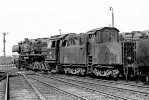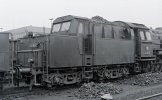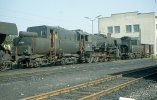Penultimate is indeed the correct word, Dave, but I find my phraseology more poetic.

Pretentious? Moi? Thanks again for the additional info vis-a-vis the German photos. This will be added to the descriptions. Also Roger - thanks for your musings and Michael for a bit more detail.
Martin - yours explains the Carlisle Upperby plate. I've always regarded the locoshed books as a primary source which is why I'm always on the look out for them but they clearly have the allocation in April 1957 and 1959 wrong. I'll be grateful if you'll confirm your source so I can add it to the details as a reference. As for the 9F - as Arun advises, the last one by build date was 92220, not 92250. Interesting thoughts from others why Swindon was last to build. I suspect the works building them were advised the numbers to use and Swindon simply had too much work on - or maybe Jan is right and Swindon recognised the PR opportunity and delayed their builds to suit. Or maybe Rob is actually correct.

Additional info from Arun and Martin helps put the 9F builds in context.
Then back to Germany. Although I know nothing of German locos I understand your thinking, Roger, but thanks Mick, your two posts are pretty well chapter and verse.
All in all I've been rather pleased with the reaction to these German photos and the interest they've engendered. More to come!
A note here to say that there'll be a pause in postings for a week or so while I get all the data now collected in to some sort of readable format. I've decided how to do it so it lies alongside the photos in such a way that the detailed and therefore long strings of info doesn't get lost but it'll take a while. The timing of this pause has no relevance as far as the photo series are concerned, just that I've set my mind to the task so it must be done.
Moving on... A4 60031 Golden Plover with a 64B shed plate at Kings Cross having arrived with The Elizabethan on 26th July 1961. This loco has featured three times previously and this photo actually very effectively answers the question of whether a Haymarket engine got as far as London. Well, here's the living proof! It was at Haymarket from new (BR Database), then to St Rollox in February 1962 and was withdrawn from there at the end of October 1965. (SLS). It was scrapped at Campbells, Shieldhall, in December the same year. (BR Database). Haymarket were clearly proud of their A4s judging by the external condition.
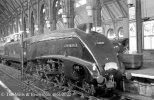
Another A4, 60017 Silver Fox on an up relief at Harringay West on 22nd July 1961. This is another loco that's featured three times previously. It was a resident of Kings Cross where it had lived since new at the time of the photo, moving to New England in June 1963 and being withdrawn in October. (SLS). It went to Doncaster Works for disposal which was completed by the year end. (BR Database).
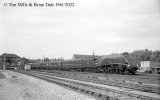
A3 60103 Flying Scotsman again on an up Newcastle train at Harringay West on 22nd July 1961. The history of this loco is, of course, well known and it's been in these pages three times peviously. Suffice to say that it was a Kings Cross engine and had been since April 1957, withdrawn in January 1963. (SLS).
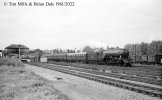
Back to Germany...
Bahnbetriebswerk (Bw) Rheine in March 1974 again. 2-10-0 051 816-7.
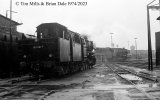
Probably Rheine Station and oil burning Pacific 012 061-8.
Edit. Yorkshire Dave:
This is Emden Hbf - At the time of these photos the electrification terminated at Rheine. The Rheine-Emden section was electrified later.
On the left Alfred Wegner Eisenhandel - Emden was and still is located in Emden.
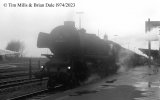
In the shed or yard at Bahnbetriebswerk (Bw) Rheine in March 1974 and coal fired 2-10-0 044 375-4.
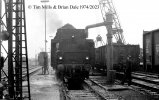
Brian


 .
.


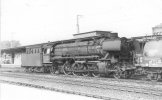
 Pretentious? Moi? Thanks again for the additional info vis-a-vis the German photos. This will be added to the descriptions. Also Roger - thanks for your musings and Michael for a bit more detail.
Pretentious? Moi? Thanks again for the additional info vis-a-vis the German photos. This will be added to the descriptions. Also Roger - thanks for your musings and Michael for a bit more detail. Additional info from Arun and Martin helps put the 9F builds in context.
Additional info from Arun and Martin helps put the 9F builds in context.





